Physical Address
304 North Cardinal St.
Dorchester Center, MA 02124
These are classified into 33 groups (1–33) ▸ abnormalities are intrinsic to bone and cartilage and will continue to evolve throughout life
Dysplasias: abnormalities of bone ± cartilage growth
Osteodystrophies: abnormalities of bone ± cartilage texture
Conditions referenced elsewhere
Group 25 (dysplasia with increased bone density)
Osteogenesis imperfecta (Section 5 Chapter 7 , Osteogenesis imperfecta)
Group 31 (disorganized development of cartilagenous and fibrous skeletal components)
Multiple cartilaginous exostoses (diaphyseal aclasis) (Section 5 Chapter 5 , Osteochondroma )
Enchondromatoses (± haemangiomas) (Section 5 Chapter 5, Benign bone tumours: (En)chondroma)
Fibrous dysplasia (Section 5 Chapter 5 , Fibrous dysplasia )
These are classified into 3 groups (A–C)
They are due to altered blastogenesis occurring during the 1 st 6 weeks of life ▸ previously normal bones will remain so (unlike an osteochondrodysplasia) ▸ more than 1 bone may be involved
Autosomal dominant ▸ multiple skeletal abnormalities (dysplastic knees and elbows) ▸ dysplastic fingernails ▸ clinodactyly (curving of the 5 th finger towards the 4 th finger) ▸ renal disease
Posterior iliac horns ▸ absent or hypoplastic patellae ▸ hypoplastic lateral femoral condyles ▸ genu valgum ▸ hypoplastic capitellum ▸ radial head dislocation ▸ short 5 th metacarpals
Sporadic (autosomal dominant in some families) ▸ abnormalities are present from birth ▸ malformations of the skull, face, hands and feet ▸ proptosis ▸ high arched or cleft palate ▸ bifid uvula
Progressive carpal and tarsal fusions ▸ progressive ankylosis of the phalangeal joints ▸ dislocated radial heads ▸ progressive fusion within the cervical spine (commonly C5/C6) ▸ progressive fusion of the large joints ▸ hypoplasia of the glenoid fossae
Craniosynostosis: premature fusion of the skull sutures and facial bones
‘Mitten’ or ‘sock’ deformities: these are due to syndactyly (fused digits) of the hands and feet
Autosomal dominant ▸ ear deformities ▸ deafness ▸ downslanting eyes ▸ lateral coloboma of the lower eyelid ▸ hypoplastic malar bone ▸ cleft palate
Symmetrical stenosis or atresia of the external auditory meati ▸ maxillary hypoplasia ▸ mandibular hypoplasia ▸ hypoplastic paranasal sinuses
Craniofacial abnormalities (e.g. brachycephaly, microcephaly, hypertelorism and relatively small facial bones)
The iliac wings are flared with relatively horizontal acetabulae ▸ frequently there are 11 pairs of gracile ribs ▸ there are often two ossification centres within the manubrium sterni (normally only one) ▸ atlantoaxial subluxation and instability with hypoplasia of the odontoid process (which is frequently a cause of myelopathy) ▸ generalized joint laxity ▸ relatively tall vertebral bodies ▸ short hands with clinodactyly of the little finger due to a hypoplastic middle phalanx
Associations: congenital heart lesions (e.g. endocardial cushion defects and intra- and extracardiac shunts) ▸ duodenal atresia and stenosis ▸ Hirschsprung's disease ▸ anorectal anomalies
Short stature ▸ cubitus valgus ▸ webbed neck ▸ widely spaced nipples ▸ lymphoedema
Patients have a classical form of ovarian dysgenesis (with streak ovaries and a small uterus) ▸ a 25% incidence of associated ovarian tumours such as a dysgerminoma (occurring up to the age of 20 years)
A short 4 th metacarpal ▸ flattening of the medial tibial condyle with a transitory exostosis ▸ beaked vertebral bodies ▸ osteoporosis ▸ scoliosis ▸ coarctation of the aorta ▸ increased occurrence of urinary tract anomalies (e.g. a horseshoe kidney) ▸ delayed skeletal maturation
Madelung deformity: a reduced angle between the distal radial and ulnar metaphyses
Autosomal dominant ▸ multiple neurofibromas and schwannomas ▸ axillary freckling, café au lait spots and molluscum fibrosum
Up to 85% of patients with neurofibromatosis manifest a musculoskeletal abnormality
| Radiographic musculoskeletal features of neurofibromatosis | |
| Soft tissues |
|
| Skull |
|
| Spine |
|
| Ribs |
|
| Tubular bones |
|
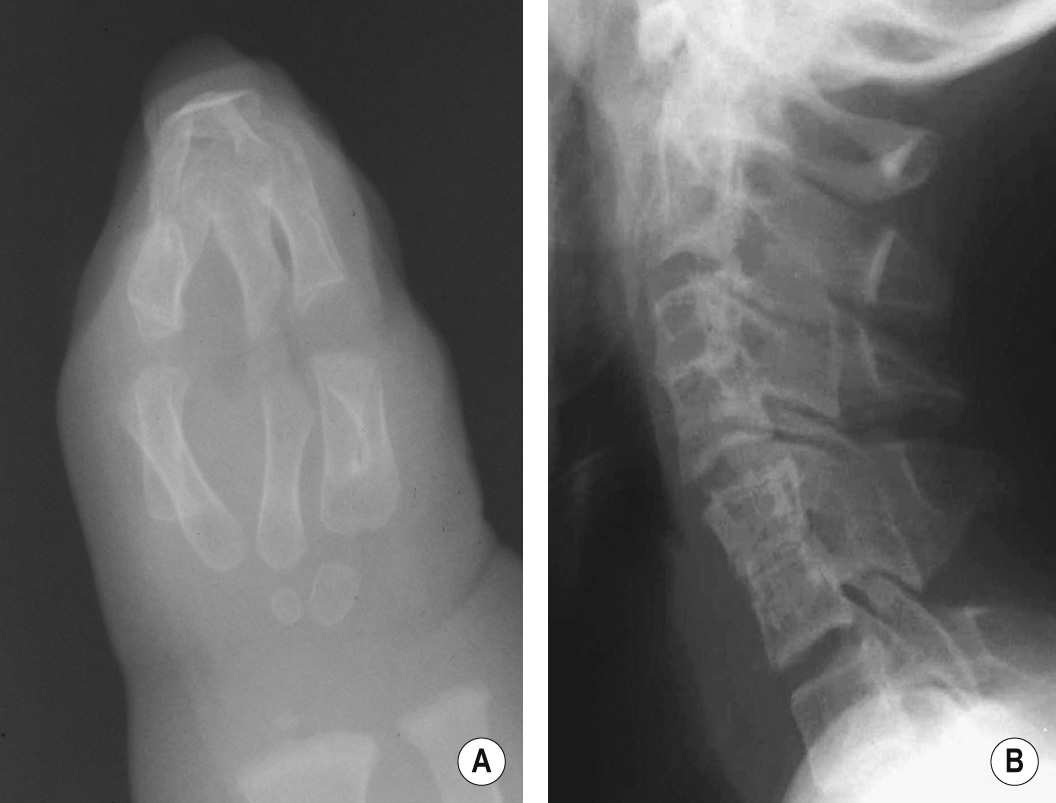
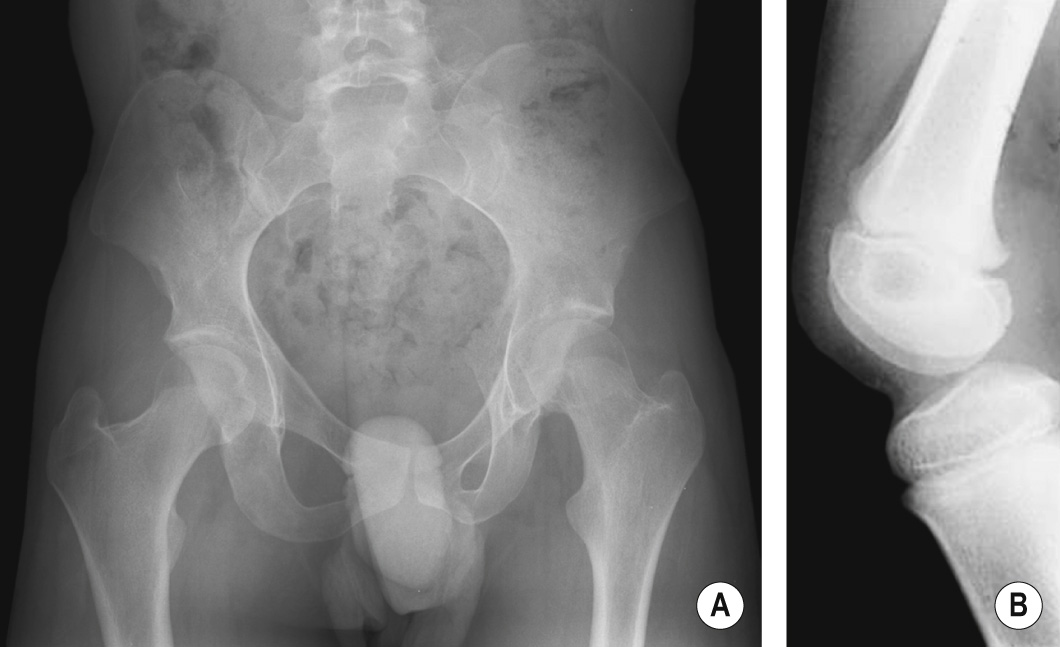
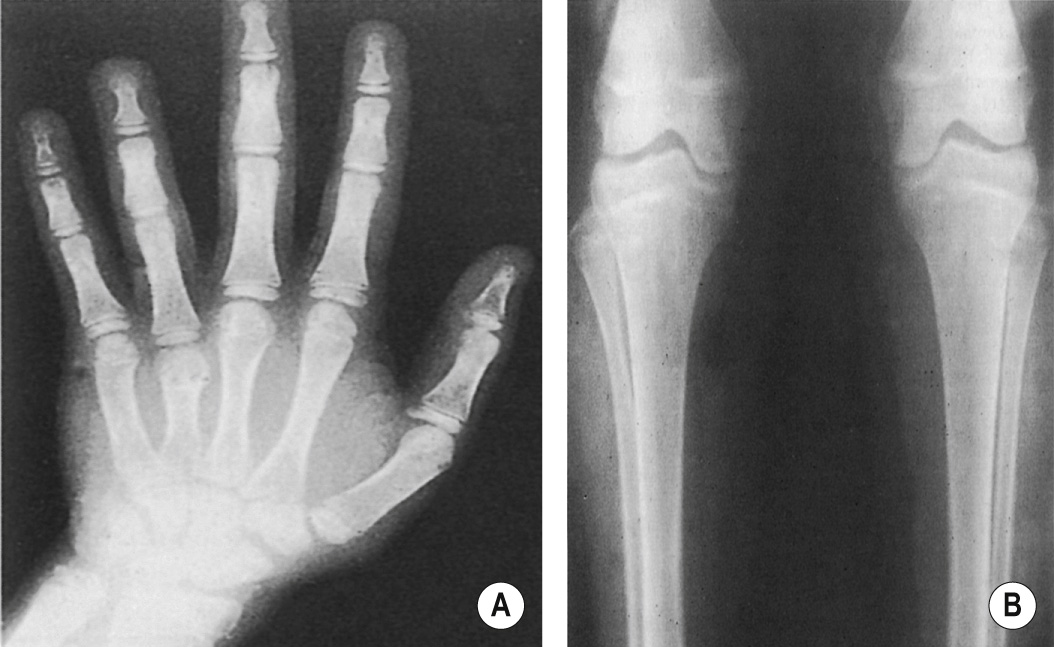
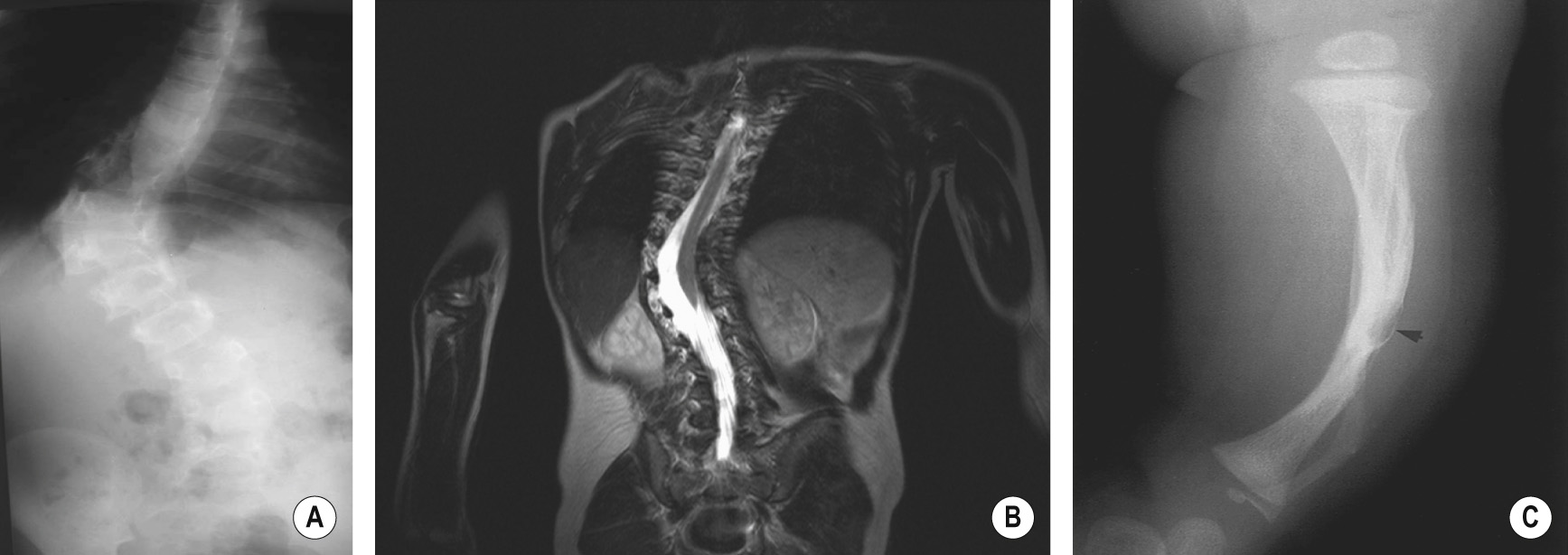
This results from defective endochondral bone formation
Limb shortening: rhizomelic (proximal) ▸ mesomelic (medial) ▸ acromelic (distal)
Autosomal dominant ▸ short limbs and trunk ▸ narrowed thorax with respiratory distress in infancy ▸ bowed legs ▸ lumbar lordosis ▸ prominent forehead with a depressed nasal bridge ▸ hydrocephalus, brainstem and spinal cord compression (dilatation of lateral cerebral ventricles)
A decreasing interpedicular distance within the lumbar spine (travelling caudally) ▸ short vertebral pedicles ▸ posterior vertebral body scalloping ▸ flat acetabular roofs ▸ short ribs and short wide tubular bones ▸ a large skull vault and a small foramen magnum ▸ relative overgrowth of fibula
‘Bullet-shaped’ vertebral bodies: with an antero-inferior anterior beak
‘Tombstone’ appearance: squared small iliac wings with a small sciatic notch
‘Champagne glass’ pelvis: the pelvic inlet resembles a champagne glass
‘Chevron’ deformity: V-shaped growth plate notches
‘Trident hand’: the fingers are all the same length and diverge into 2 pairs
This is a fatal autosomal recessive dwarfism where the abnormalities are similar to those seen in achondroplasia (but are much more severe)
Abnormalities include: severe short limb dwarfism ▸ unossified vertebral bodies ▸ a large head with normal or reduced ossification
Type I: severe
Type II: less severe ▸ it is caused by type II collagen abnormalities leading to abnormal bone and cartilage formation
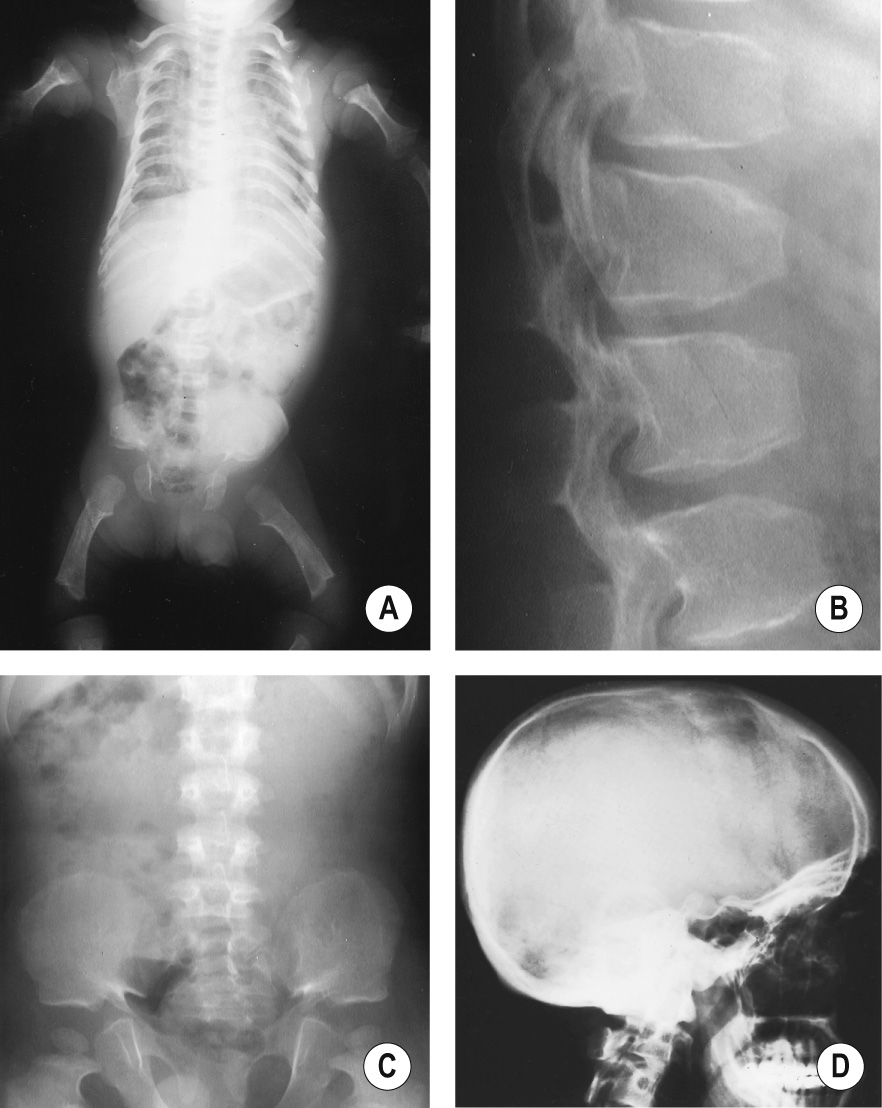
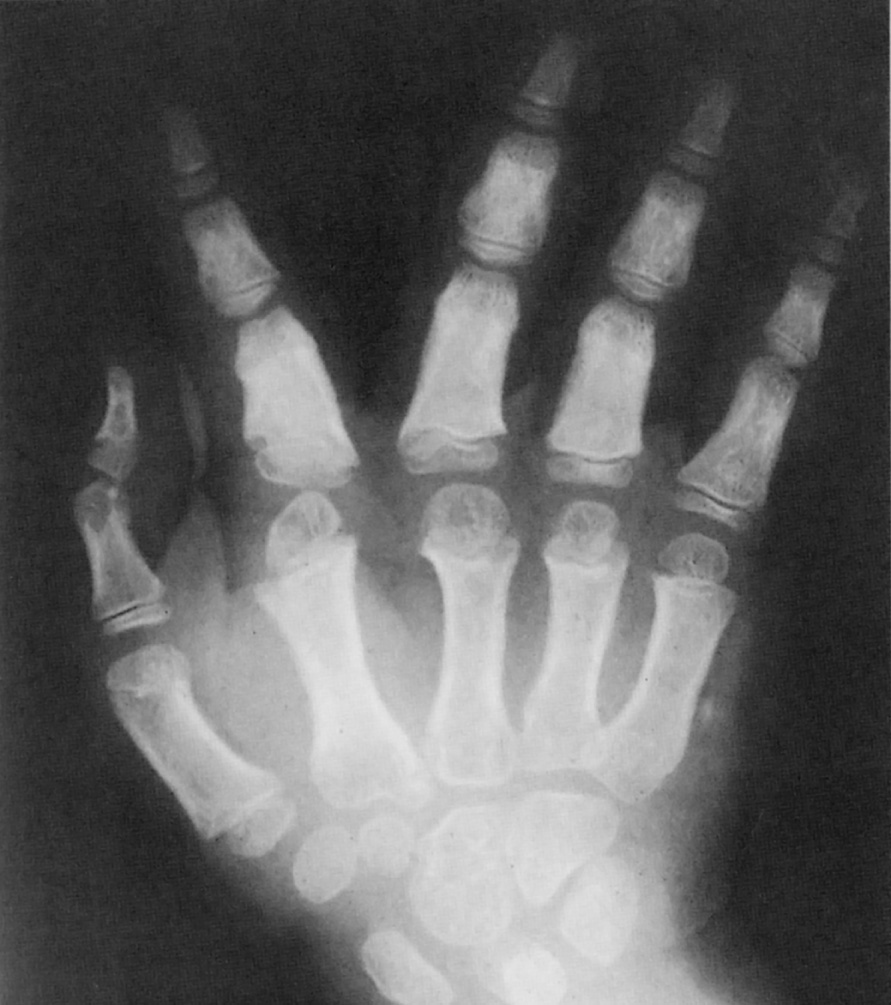
This is also known as ‘achondroplasia tarda’ with milder features than those seen with achondroplasia
Autosomal dominant ▸ variable short stature and a prominent forehead
No normal widening is demonstrated in the interpedicular distance within the lumbar spine (travelling caudally) ▸ short and relatively broad long bones ▸ elongation of the distal fibula and ulnar styloid process ▸ variable brachydactyly
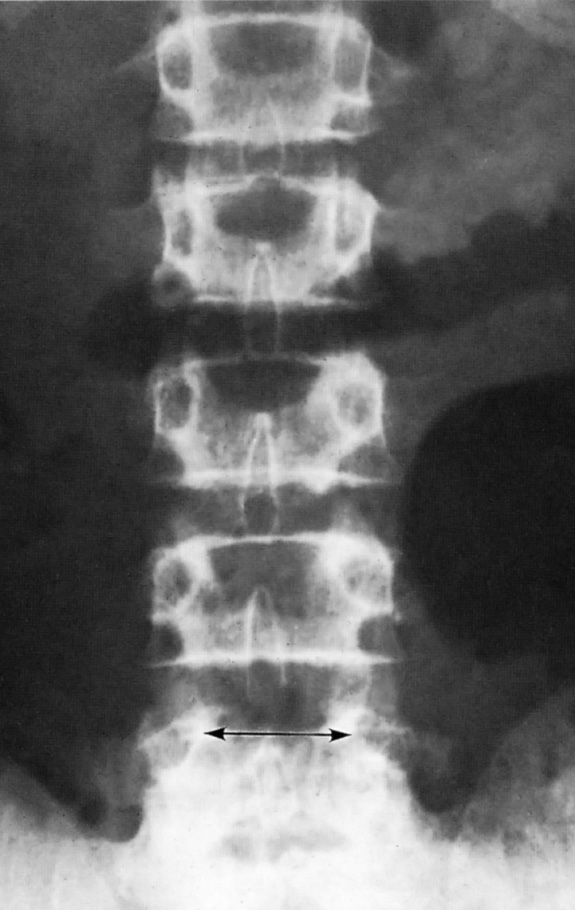
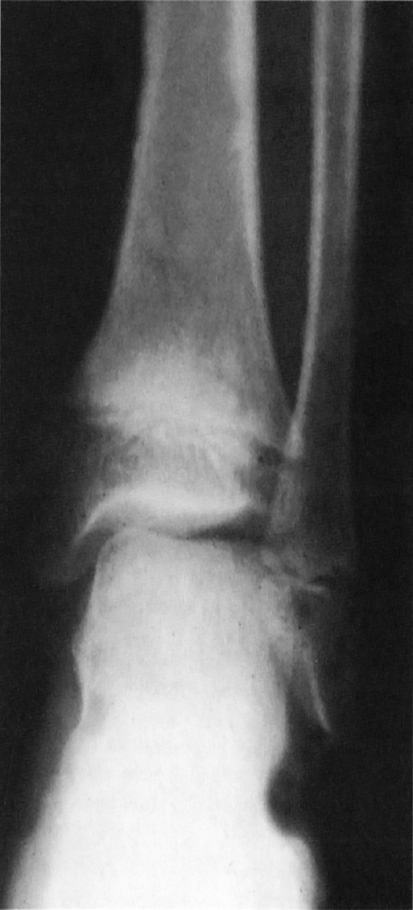
Sporadic, autosomal dominant mutation ▸ this is the most common lethal neonatal skeletal dysplasia ▸ short markedly curved limbs ▸ respiratory distress due to a (small thoracic cage)
Short ribs with wide costochondral junctions ▸ severe platyspondyly ▸ horizontal acetabular roofs with medial spikes ▸ small sacroiliac notches ▸ marked shortness and bowing of the long bones ▸ irregular metaphyses ▸ short broad tubular bones in the hands and feet ▸ small scapulae
‘Telephone handle’ appearance of the long bones: this is due to metaphyseal flaring
‘Cloverleaf skull’: this is due to lateral temporal bulging
Type 1: normal skull
Type 2: ‘clover leaf’ skull
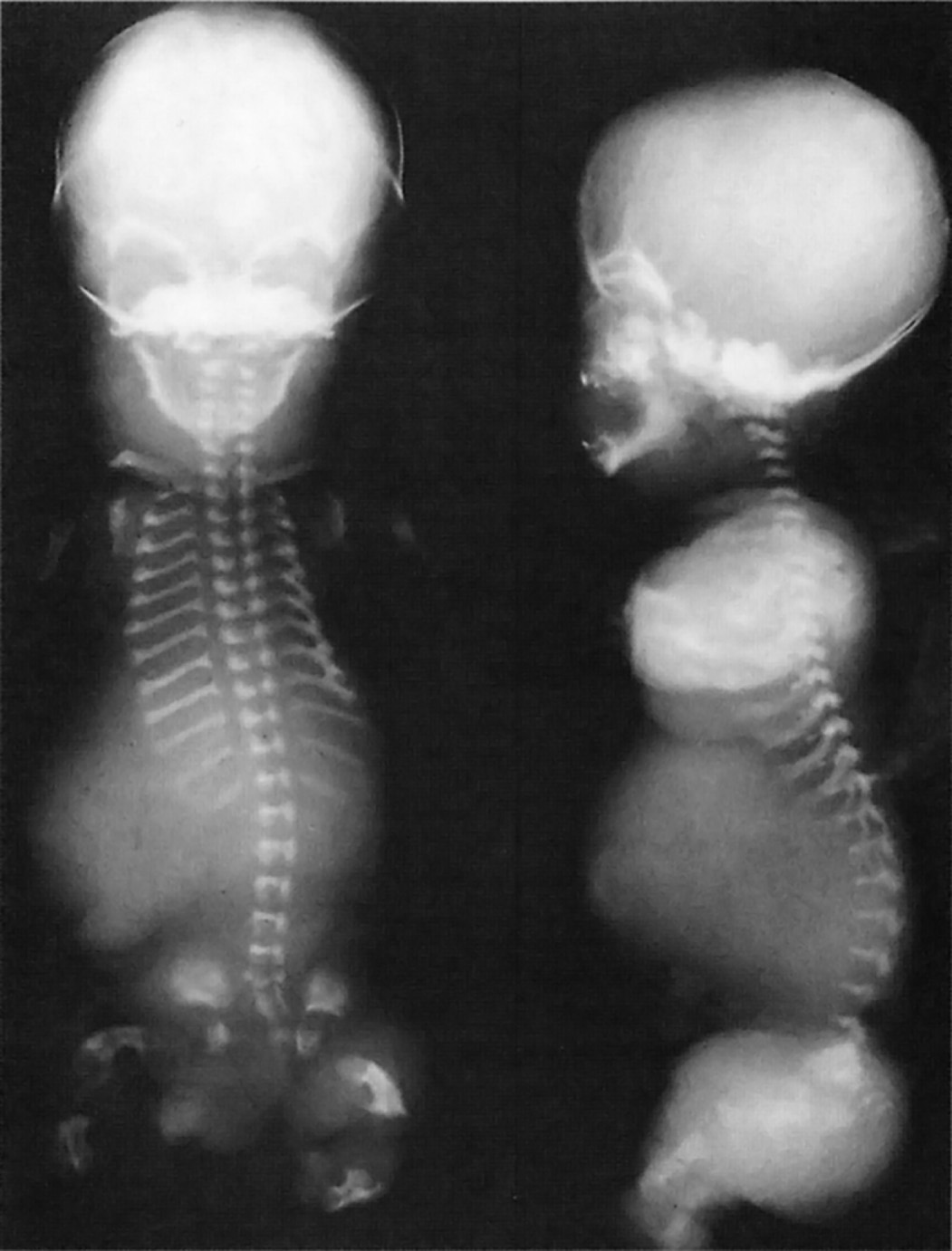
Autosomal recessive (often lethal) ▸ respiratory problems with a long narrow thorax ▸ short hands and feet ▸ nephronophthisis in later-life survivors
Small thorax with short ribs (horizontally orientated) ▸ widened costochondral junctions ▸ high clavicles ▸ short iliac bones ▸ horizontal acetabula with medial and lateral ‘spurs’ (‘trident’ appearance) ▸ ‘wineglass’ pelvis ▸ premature appearance of the proximal femoral ossification centres ▸ cone-shaped phalangeal epiphyses ▸ may have polydactyly (10%)
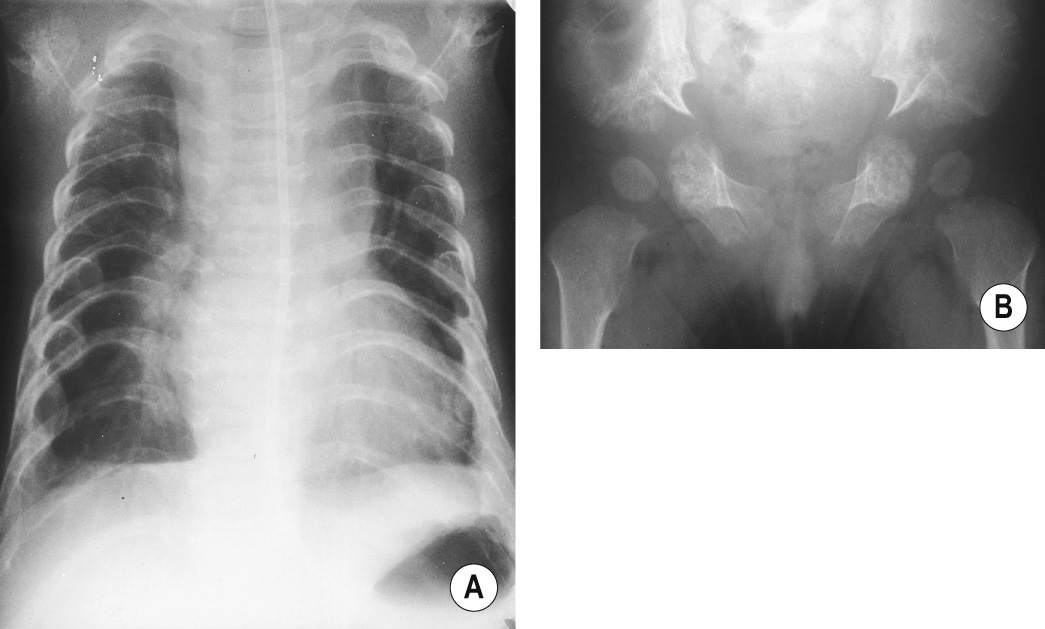
The development of dwarfism changes over time – the trunk gradually shortens relative to the limbs (due to the developing kyphoscoliosis) – hence the name 'metatropic'
Variable inheritance (autosomal dominant or recessive) ▸ short limbs ▸ relatively narrow chest ▸ small appendage in the coccygeal region (tail) ▸ progressive kyphoscoliosis
Short tubular bones with marked metaphyseal widening (‘dumb-bell’) ▸ platyspondyly ▸ relatively large intervertebral discs ▸ flat acetabular roofs ▸ short iliac bones ▸ short ribs with anterior widening ▸ hypoplastic odontoid process
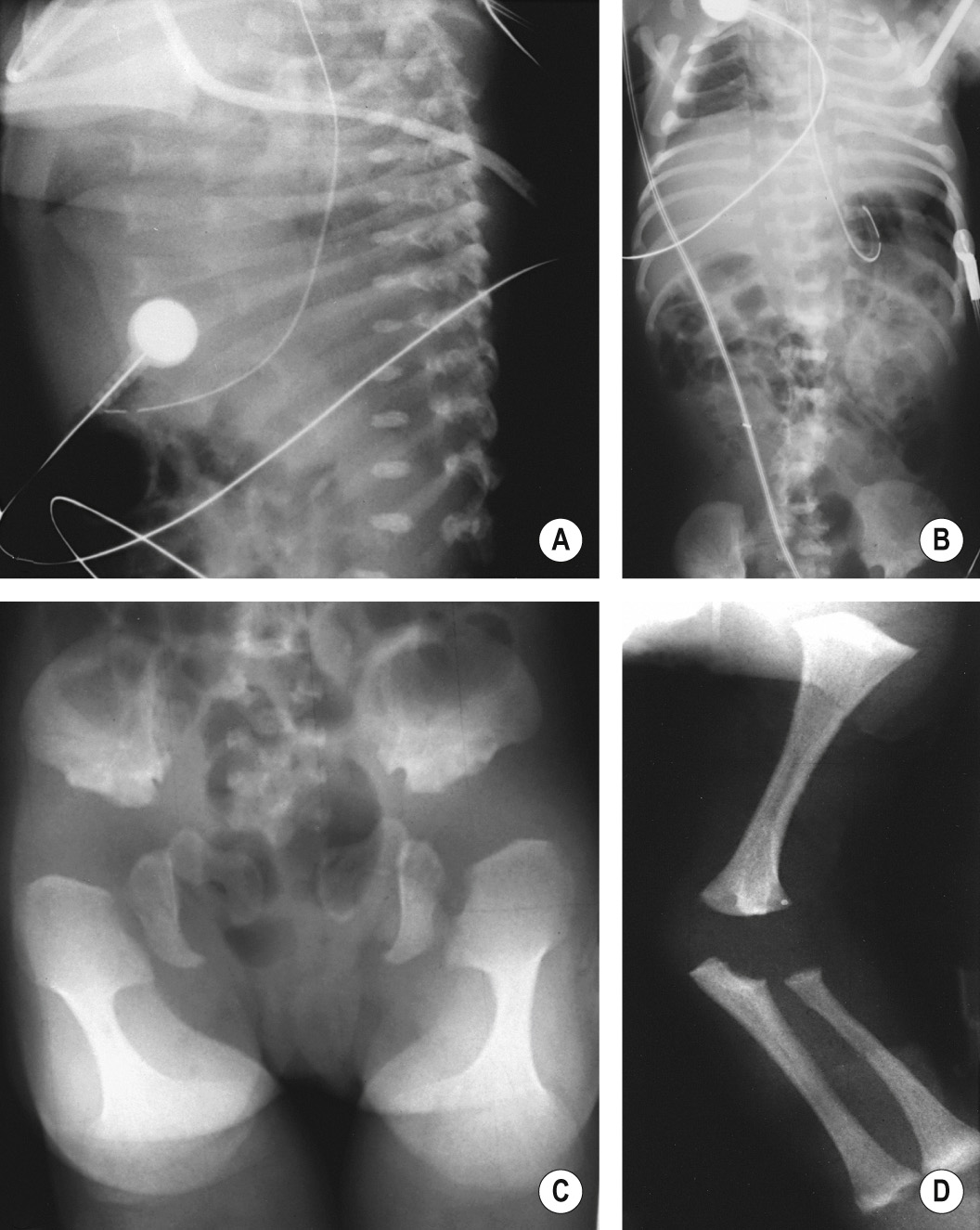
Severe short-limbed dwarfism
Schmid type: more common ▸ mild ▸ predominantly involves the lower limbs
Jansen type: less common ▸ more severe ▸ symmetrical involvement of all tubular bones
Autosomal dominant ▸ short limbs, short stature, presenting in early childhood ▸ genu varum (bow legs) ▸ waddling gait
Metaphyseal flaring ▸ irregular widened growth plates (most marked at the hips) ▸ increased density and unevenness of the metaphyses (particularly the upper femora and around the knees) ▸ large femoral capital epiphyses ▸ coxa vara ▸ femoral bowing ▸ anterior cupping of the ribs ▸ normal spine
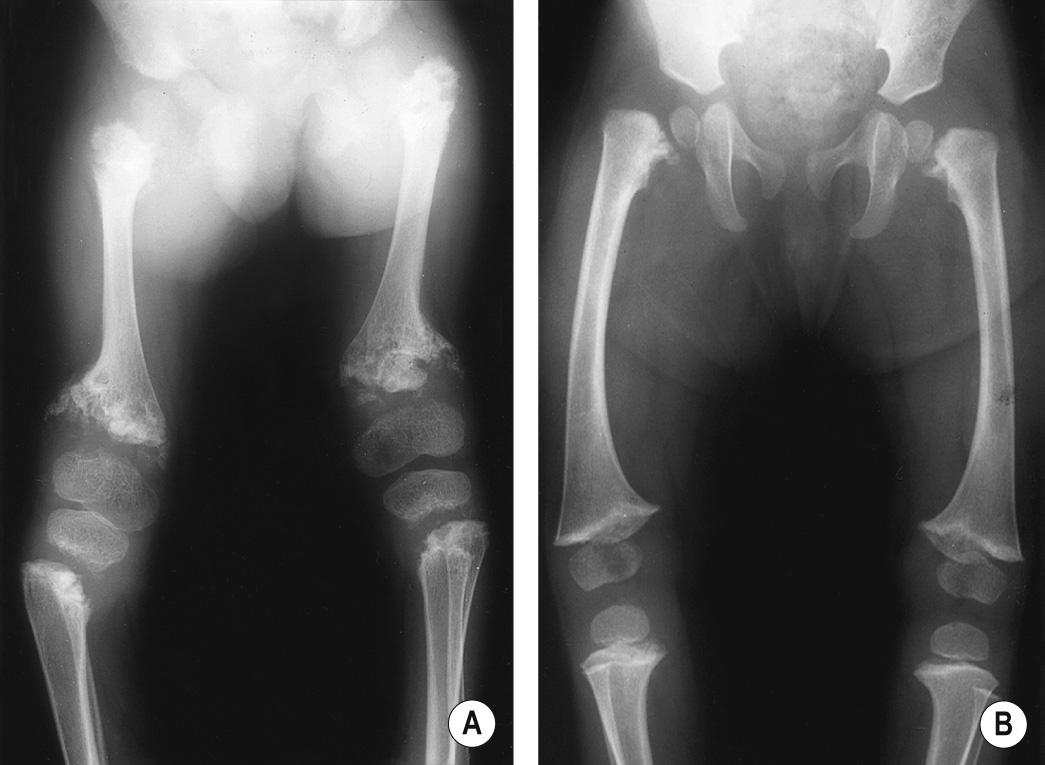
Autosomal recessive ▸ short stature ▸ short limbs (more marked distally) ▸ polydactyly ▸ hypoplasia of the nails and teeth ▸ ectodermal dysplasia with sparse hair ▸ congenital cardiac defects (e.g. ASD) ▸ fusion of upper lip and gum
Short ribs in infancy ▸ short iliac wings ▸ ‘trident’ appearance – the pelvis becomes more normal in childhood ▸ premature ossification of the femoral capital epiphyses ▸ laterally sloping proximal tibial metaphysis ▸ exostosis of the medial upper tibial shaft ▸ carpal fusions ▸ cone-shaped epiphyses (middle phalanges) ▸ polydactyly of the hands and feet
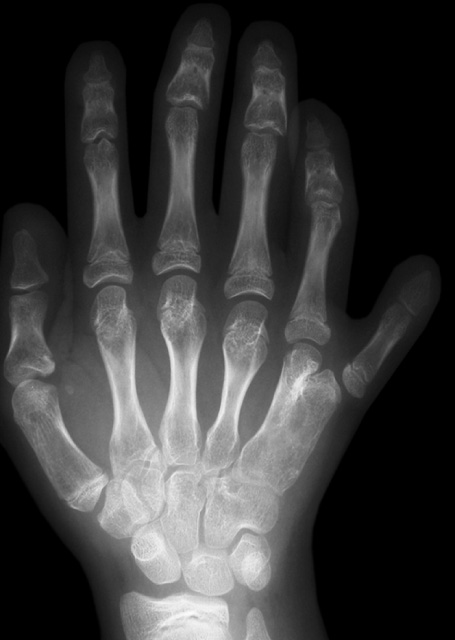
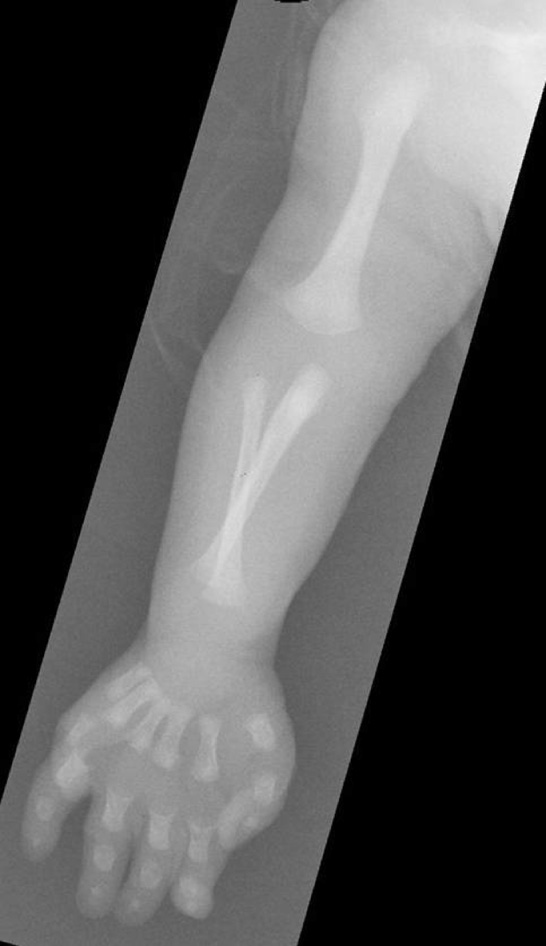
Autosomal dominant ▸ short stature ▸ cleft palate ▸ myopia ▸ maxillary hypoplasia ▸ thoracic kyphosis and lumbar lordosis ▸ barrel-shaped chest
Ovoid, pear-shaped, irregular-sized vertebral bodies in infancy ▸ irregular platyspondyly in later life ▸ L5 smaller than L1 in infancy ▸ odontoid hypoplasia and cervical spine instability ▸ short long bones ▸ absent ossification of the epiphyses of the knees, talus and calcaneus at birth ▸ pubic and ischial hypoplasia ▸ severe coxa vara developing in early childhood ▸ horizontal acetabulum
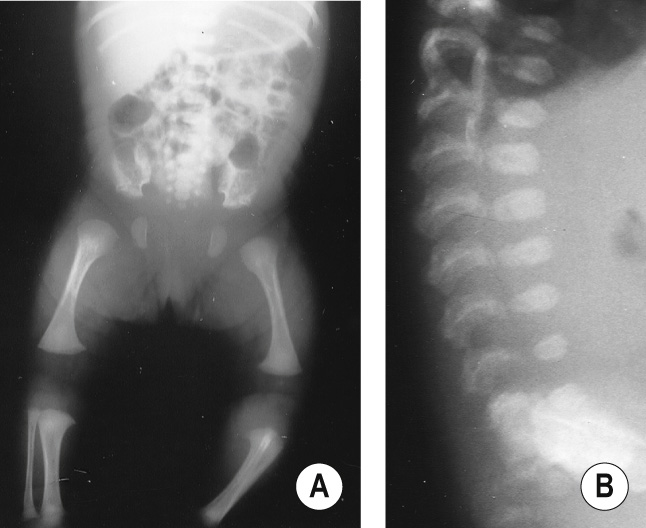
Become a Clinical Tree membership for Full access and enjoy Unlimited articles
If you are a member. Log in here